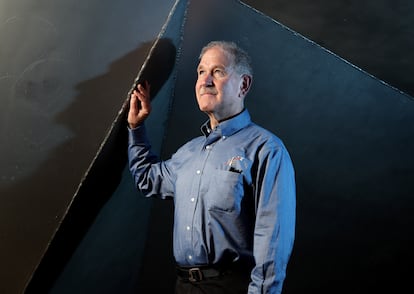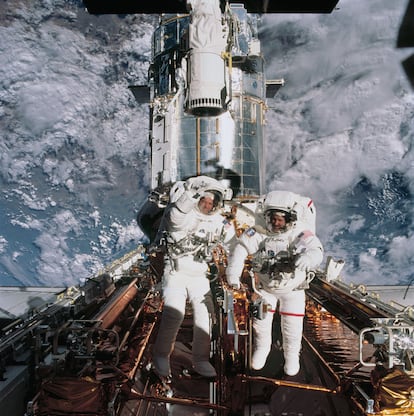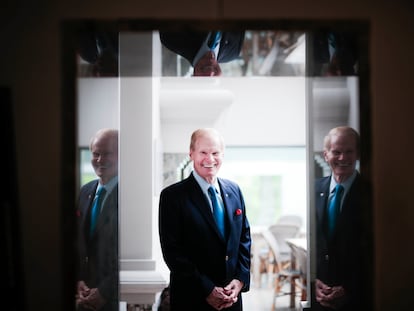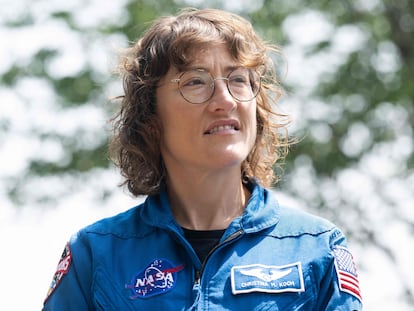John Grunsfeld, astronaut: ‘I didn’t think there were aliens here until Donald Trump became president’
The former NASA chief scientist has left the planet five times, and has come to spend more than eight hours floating alone in space

There’s a photograph of astronaut John Grunsfeld that takes your breath away. In the image – snapped on March 8, 2002 – he’s seen hanging from a robotic arm in the vastness of space, with the towering blue sphere of our planet beneath his feet. “That day, I was a plumber,” he recalls. Grunsfeld carried a giant radiator in his hands – “as if it were a surfboard” – to make an adjustment to the Hubble telescope, which was launched in 1990 to be the eye of humanity in space.
The American astronaut – born in Chicago 64 years ago – left Earth five times, between 1995 and 2009. On three of these missions, he solved problems with Hubble, a sophisticated 10-ton machine that circles the planet at a speed of more than 17,000 miles per hour. During one of his spacewalks, Grunsfeld hit the record for staying outside the ship – more than eight hours – while wearing a diaper, so that he could last as long as necessary.
Thanks to his repairs to the space telescope, humanity has made amazing discoveries. These include finding out about the existence of supermassive black holes at the center of almost all galaxies, identifying the presence of the enigmatic dark energy that drives the expansion of the cosmos, as well as capturing the deepest image of the universe. It was taken in visible light, from a light trail emitted more than 13 billion years ago, just 800 million years after the Big Bang.
Grunsfeld – an astrophysicist and NASA’s former chief scientist – answers questions from EL PAÍS before giving a lecture in Madrid.
Question. What does it feel like to be floating in space, next to the Earth?
Answer. It’s incredible that a human can be in such an inhospitable place: the vacuum can kill you, micrometeorites can kill you… the temperature ranges from over 200 degrees to minus 200 degrees. It’s a place where people don’t belong, but in the spacesuit we do fine. The suit is a one-person spaceship. People who jump off cliffs in wingsuits that imitate flying squirrels say that’s the essence of a human flying. They’re falling, but they feel like they’re flying. In space, it’s the same. It’s just you, a suit and space. It’s a magical feeling.
When you’re working on the Hubble, it’s a lot of focus on the task and not so much on the beauty and the experience. So much so that I said to my crew members, when we look at the timeline, let’s plan for each of us to have five minutes to just enjoy space. During my relaxation break, I really felt extraordinarily peaceful.
Q. In 1961, Nikita Khrushchev – the premier of the Soviet Union and first secretary of the Communist Party – claimed that cosmonaut Yuri Gagarin flew into space, but saw no God there. Did you see God?
A. No. And I didn’t see aliens either. Depending on your religious point of view, you will never see God, or you will see God everywhere.

Q. Astronaut Edgar Mitchell went to the Moon and, upon his return, believed that there were aliens here on Earth.
A. Well, I didn’t think there were aliens here until Donald Trump became president!
Q. What do we know thanks to the Hubble Space Telescope that we didn’t know before?
A. One of the great discoveries – which resulted in the Nobel Prize in Physics in 2011 – is that, for six billion years, the expansion of the universe has been accelerating, rather than slowing down. This is what physicists now call the pressure of dark energy, which makes the entire universe expand faster and faster. We have no idea why. Those discoveries were made because, in 2002, we installed the Advanced Camera for Surveys (ACS) on Hubble. The telescope was designed to confirm the existence of black holes – it succeeded in doing so. We also discovered that galaxies routinely collide and create larger galaxies. Our Milky Way has swallowed a bunch of other galaxies! And, in about five billion years, we’ll collide with Andromeda and the two galaxies will form a megagalaxy.
Another interesting thing that we saw with Hubble is that a comet – Shoemaker-Levy-9 – hit Jupiter. We thought it was amazing how lucky we were to see something hit that planet… but it turns out we’ve seen a lot of things hit it since. Jupiter is a kind of the vacuum cleaner of the solar system. We had no idea that Jupiter would be hit so often. It’s good that we have a Jupiter, because otherwise, those things could hit Earth. The fossil record of dinosaurs tells us what can happen…
Q. Does Jupiter clean up the junk from space?
A. Yes, Jupiter is so big – and its force of gravity is so strong – that things get altered by the Jupiter’s mass and then hit Jupiter and get absorbed in.
Q. What discoveries do you expect from the James Webb Space Telescope, the largest in history? It was launched in December of 2021 as a successor to Hubble.
A. The main reason James Webb was built is because Hubble is a telescope that sees visible light, which we [humans] can see: the colors of the rainbow. James Webb can also see ultraviolet and near-infrared light. Hubble can only see so far – we wanted to see more.
Imagine that your parents give you an album with photos of you from the age of four to adulthood. And you say, “Where are the baby pictures?” And they answer: “We don’t have baby photos. We don’t know what you looked like as a baby, because light was invisible then. We couldn’t see you.” Our view of the universe doesn’t have baby pictures, but the James Webb – being an infrared telescope – can see farther back in time than Hubble. [This telescope] can offer us children’s photographs of galaxies.

Q. And what about baby photographs of our own solar system?
A. The James Webb [Space Telescope] also has a unique feature: when it takes a picture, each pixel can be broken down into its component colors using spectroscopy, which tells us what kind of atoms are producing the light, what their temperature is, and how many electrons they have. This gives us the physical characteristics of those objects.
In our own solar system, the James Webb can do great things. For example, a few days ago, we saw the image of Enceladus – a moon of Saturn – which shows a giant plume of water. [In 2005], the Cassini probe already observed small jets of water and flew through them, detecting all the chemical elements necessary for life. Enceladus is a very small moon – 620 miles wide, with an ice cap, a warm ocean and a rocky core. In that ocean, there could be life. We don’t know, but there could be, so we want to find out. The James Webb shows us not only the plumes [of water], but also the water escaping and forming the E ring around Saturn. And because you can examine every pixel [of the photos it takes], we’ll be able to look for the presence of simple organic molecules (which allow for life).
Q. Can we detect aliens with the James Webb?
A. The hope is that, by observing the planets around nearby stars, we can analyze their atmospheres. If we’re very lucky, we might find a planet that appears to have life on it. But James Webb isn’t big enough, it doesn’t have the full wavelength range needed to find life on a planet like Earth, which is very close to a super-bright star. The telescope won’t be able to suppress that starlight. If it’s a red dwarf star and an Earth-sized planet, yes, you could study it… but those stars may not have the right conditions to create life. We really don’t know.
Q. So, to search for aliens, we’ll have to build another telescope.
A. Yeah, I think it’ll be the next generation of telescopes.
Q. Back in 1972, Wernher von Braun (NASA’s deputy director) predicted that the first child would be born on the Moon before the year 2000. What do you think? When will the first baby be born on the Moon?
A. I think it’ll be a long time. I know there’s a lot of excitement about lunar exploration – and I am very excited myself – but I don’t buy all these plans by China, Russia and the United States to have lunar bases around 2030. I’ll be very happy if the United States manages to land on the moon [again] before the end of this decade.
When I was NASA’s chief scientist in 2003 and 2004, we developed a plan for a person to land on the Moon in 2020. And, of course, that plan was put on hold as soon as the president changed. Even with our current plans, hopefully, we’ll fly the Artemis 2 mission in 2024, maybe 2025… but we’ll need a lunar lander and many other things before we can land on the Moon. Achieving it before 2030 would be exciting.
The Moon only has one-sixth the gravity of Earth, so we don’t even know if it’s a good idea to have a baby there, the bones may not develop properly. Mars is another story – its gravity is superior. And, I think, once we do send people to Mars, it will probably be for a long time, because it’s very hard to go and very hard to come back.
Q. Do you think it’s more likely for a child to be born on Mars instead of on the Moon?
A. I think so, yeah. That would be my guess. But I think to actually have moon colonies – you know, where people live for a very long period of time on the moon rather than going to visit – it’ll take a very long time. You know, since the 1950s, we’ve had a permanent presence in Antarctica and I don’t think any babies have been born there.
Tu suscripción se está usando en otro dispositivo
¿Quieres añadir otro usuario a tu suscripción?
Si continúas leyendo en este dispositivo, no se podrá leer en el otro.
FlechaTu suscripción se está usando en otro dispositivo y solo puedes acceder a EL PAÍS desde un dispositivo a la vez.
Si quieres compartir tu cuenta, cambia tu suscripción a la modalidad Premium, así podrás añadir otro usuario. Cada uno accederá con su propia cuenta de email, lo que os permitirá personalizar vuestra experiencia en EL PAÍS.
¿Tienes una suscripción de empresa? Accede aquí para contratar más cuentas.
En el caso de no saber quién está usando tu cuenta, te recomendamos cambiar tu contraseña aquí.
Si decides continuar compartiendo tu cuenta, este mensaje se mostrará en tu dispositivo y en el de la otra persona que está usando tu cuenta de forma indefinida, afectando a tu experiencia de lectura. Puedes consultar aquí los términos y condiciones de la suscripción digital.
More information
Archived In
Últimas noticias
Maduro pleads not guilty before the federal court in New York: ‘I am still the president of Venezuela’
A new test can detect Alzheimer’s from a finger prick
UN team enters Sudanese city of El Fasher after paramilitary massacre: ‘It’s like a ghost town’
A recipe for resistance: Indigenous peoples politicize their struggles from the kitchen
Most viewed
- Gilles Lipovetsky: ‘If you want to live better and fall in love, take Prozac, don’t look to philosophy’
- Alain Aspect, Nobel laureate in physics: ‘Einstein was so smart that he would have had to recognize quantum entanglement’
- Alvin Hellerstein, a 92-year-old judge appointed by Bill Clinton, to preside over Maduro’s trial in New York
- Maduro’s downfall puts China’s relationship with Venezuela to the test
- Why oil has been at the center of Venezuela-US conflicts for decades











































